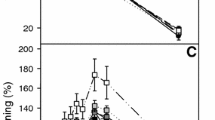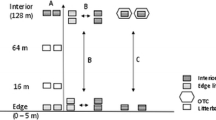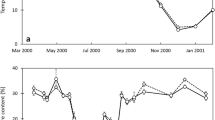Abstract
Using reciprocal leaf litter transplants, we investigated the effects of contrasting environments (urban vs. rural) and intraspecific variations in oak leaf litter quality on mass loss rates and nitrogen (N) dynamics along an urban-rural gradient in the New York City metropolitan area. Differences in earthworm abundances and temperature had previously been documented in the stands along this gradient. Red oak leaf litter was collected and returned to its original source stand as native litter to measure decay rates along the gradient. To separate site effects from litter quality effects on decay, reciprocal transplants of litter were also made between stands at the extremes of the environmental gradient (urban and rural stands). Land-use had no effect on mass loss and N dynamics of native litter by the end of the 22-month incubation period. The lack of differences in native litter suggests the factors affecting decay were similar across the stands in this study. However, in the transplant study both environment and litter type strongly affected decay of oak leaf litter. On average urban and rural litter decomposed faster over the incubation period in urban than in rural stands (P=0.016 and P=0.001, respectively, repeated measures ANOVA). Differences in mass loss between urban and rural stands resulted in rural environments having less mass remaining than urban environments at the end of the incubation period (25.6 and 46.2% for urban and rural sites, respectively). Likewise, less N remained in leaf residue in urban sites (71.3%) compared to that in rural sites (115.1%). Litter type also affected mass loss rates during the 22-month incubation period. On average rural litter mass loss rates were faster than urban litter rates in both urban and rural stands (P=0.030 and P=0.026, respectively, repeated measures ANOVA). By the end of the incubation period, rural litter exhibited 43 and 20% greater mass loss and retained 44 and 5% less N than urban litter decomposing in the same urban and rural sites, respectively. These results suggest that different factors were controlling mass loss and N release rates along this urban-rural gradient. In urban stands, exotic earthworms and warmer temperatures may be compensating for what would otherwise be slowly decaying leaf litter because of its lower quality. Likewise, the lower quality litter produced in the urban stands may be decreasing the net release of N from litter despite higher temperatures and earthworm activity. Even though native litter decay rates were similar, the differential importance of the factors affecting decay along this gradient could alter the response of these forests to disturbance and variations in climate.






Similar content being viewed by others
References
Airola TM, Buchholz K (1984) Species structure and soil characteristics of five urban sites along the New Jersey Palisades. Urban Ecol 8:149–164
Berg B, McClaugherty C (1987) Nitrogen release from litter in relation to disappearance of lignin. Biogeochemistry 4:219–224
Berg B, Staaf H (1981) Leaching, accumulation, and release of nitrogen in decomposing forest litter. In: Persson T (ed.) Structure and function of northern coniferous forests: an ecosystem study. Ecol Bull 32:163–178
Berg B, Ekbohm G, Soderstromm B, Staaf H (1991) Reduction of decomposition rates of Scots pine needle litter due to heavy-metal pollution. Water Air Soil Pollut 59:165–177
Birk EM, Vitousek PM (1986) Nitrogen availability and nitrogen use efficiency in loblolly pine stands. Ecology 67:69–79
Blair JM (1988) Litter decomposition, nitrogen dynamics and litter microarthropods in a southern Appalachian hardwood forest 8 years following clearcutting. J Appl Ecol 25:683–698
Carreiro MM, Howe K, Parkhurst DF, Pouyat RV (1999) Variations in quality and decomposability of red oak leaf litter along an urban-rural gradient. Biol Fert Soils 30:258–268
Carsile A, Brown AHF, White EJ (1966) Litter fall, leaf production and the effects of defoliation by Tortrix viridana in a sessile oak (Quercus petraea) woodland. J Ecol 54:65–85
Fenn ME (1991) Increased site fertility and litter decomposition rate in high pollution sites in the San Bernardino Mountains. For Sci 37:1163–1181
Fenn ME, Dunn, PH (1989) Litter decomposition across an air-pollution gradient in the San Bernardino Mountains. Soil Sci Soc Am J 53:1560–1567
Findlay S, Carreiro M, Krischik V, Jones CG (1996) Effects of damage to living plants on leaf litter quality. Ecol Appl 6:269–275
Fogal R, Cromack K Jr. (1977) Effect of habitat and substrate quality on Douglas Fir litter decomposition in Western Oregon. Can J Bot 55:1632–1640
Fox JF, Van Cleve K (1983) Relationship between cellulose decomposition, forest floor nitrogen, and soil temperature in Alaskan U.S.A. Taiga forests. Can J For Res 13:789–794
Geng X, Pastor J, Dewey B (1993) Decay and nitrogen dynamics of litter from disjunct congeneric tree species in old-growth stands in northeastern China and Wisconsin. Can J Bot 71:693–699
Gonick WN, Shearin AE, Hill DE (1970) Soil survey of Litchfield County. USDA Soil Conservation Service, Washington, DC.
Grodzinski W, Weiner J, Maycock PF (1984) Forest ecosystems in industrial regions. Springer, Berlin Heidelberg New York
Haines BL, Carlson CL (1989) Effects of acid precipitation on trees. In: Adriano PC, Johnson AH (eds) Acid precipitation, vol 2: biological and ecological effects. Springer, Berlin Heidelberg New York, pp 1–27
Hill DE, Sauter EH, Gonick WN (1980) Soils of Connecticut. Conn Agric Exp St Bull 787
Horner JD, Gosz JR and Cates RG (1988) The role of carbon-based plant secondary metabolites in decomposition in terrestrial ecosystems. Am Nat 132:869–883
Inman, JC, Parker GR (1978) Decomposition and heavy metal dynamics of forest litter in northwestern Indania. Env Pollut 17:34–51
Johansson MB (1994) Decomposition rates of Scots pine needle litter related to site properties, litter quality, and climate. Can J For Res 24:1771–1781
Jordan DN, Green TH, Chappelka AH, Lockaby BG, Meldahl RS, Gjerstad DH (1991) Response of total tannins and phenolics in loblolly pine foliage exposed to ozone and acid rain. J Chem Ecol 17:505–513
Kuperman RG (1999) Litter decomposition and nutrient dynamics in oak-hickory forests along a historic gradient of nitrogen and sulfur deposition. Soil Biol Biochem 31:237–244
Lee KE (1985) Earthworms: their ecology and relationships with soils and land use. Academic Press, Sydney, Australia
Luxton M (1982) Substrate utilization by the soil fauna. Oikos 39:340–341
Meentemeyer V, Berg B (1986) Regional variation in rate of mass loss of Pinus-Sylvestris needle litter in Swedish pine forests as influenced by climate and litter quality. J For Res 1:167–180
Medley KE, McDonnell MJ, Pickett STA (1995) Forest-landscape structure along an urban-to-rural gradient. Prof Geogr 47:159–168
Melillo JM, Aber JD, Muratore JF (1982) Nitrogen and lignin control of hardwood leaf litter decomposition dynamics. Ecology 63:621–626
Merrill W, Cowling EB (1966) Role of nitrogen in wood deterioration: amounts and distribution of nitrogen in tree stems. Can J Bot 44:1555–1580
Nihlgard B (1985) The ammonium hypothesis—an additional explanation to the forest dieback in Europe. Ambio 14:2–8
Pouyat RV, McDonnell MJ (1991) Heavy metal accumulation in forest soils along an urban-rural gradient in Southern New York, U.S.A. Water Air Soil Pollut 57–58:797–807
Pouyat RV (1992) Soil characteristics and litter dynamics in mixed deciduous forests along an urban-rural gradient. PhD Dissertation, Rutgers University, New Brunswick, N.J.
Pouyat RV, Parmelee RW, Carreiro MM (1994) Environmental effects of forest soil-invertebrate and fungal densities in oak stands along an urban-rural land use gradient. Pedobiologia 38:385–399
Pouyat RV, McDonnell MJ, Pickett STA (1995) Soil characteristics of oak stands along an urban-rural land use gradient. J Environ Qual 24:516–526
Pouyat RV, McDonnell MJ, Pickett STA (1997) Litter decomposition and nitrogen mineralization in oak stands along an urban-rural land-use gradient. Urban Ecosys 1:117–131
SAS Institute (1987) SAS Statistics User's Guide. SAS Institute, Cary, N.C.
Schaefer DA, Reiners WA (1990) Throughfall chemistry and canopy processing mechanisms. In: Lindberg SE, Page AL, Norton SA (eds) Acid precipitation, vol. 3: sources, deposition and canopy interactions. Springer, Berlin Heidelberg New York, pp 241–284
Scheu S (1993) Litter microflora-soil macrofauna interactions in lignin decomposition: a laboratory experiment with 14C-labelled lignin. Soil Biol Biochem 25:1703–1711
Smith WH (1990) Air pollution and forests: interaction between air contaminants and forest ecosystems, 2nd edn. Springer, Berlin Heidelberg New York
Staaf H (1987) Foliage litter turnover and earthworm populations in three beech forests of contrasting soil and vegetation types. Oecologia 72:58–6
Steinberg DA, Pouyat RV, Parmelee RW, Groffman PM (1997) Earthworm abundance and nitrogen mineralization rates along an urban-rural land use gradient. Soil Biol Biochem 29:427–430
Swift MJ, Heal OW, Anderson JM (1979) Studies in ecology, vol 5: decomposition in terrestrial ecosystems. Blackwell, Oxford
Sykes JM, Bunce RGH (1970) Fluctuations in litter-fall in a mixed deciduous woodland over a three-year period. Oikos 21:326–329
Taylor BR, Parkinson D (1988) Annual differences in quality of leaf litter of aspen (Populus tremuloides) affecting rates of decomposition. Can J Bot 66:1940–1947
Van Soest PJ, Robertson RB, Lewis BA (1991) Methods for dietary fiber, neutral detergent fiber, and nonstarch polysaccharides in relation to animal nutrition. J Dairy Sci 74:3583–3597
Zhu W, Carreiro MM (1999) Chemoautotrophic nitrification in acidic forest soils along an urban-to-rural transect. Soil Biol Biochem 31:1091–1100
Acknowledgements
We thank M. McLean, D. Parkhurst, and two anonymous reviewers for their comments on an earlier draft of this manuscript. Michelle Conant, Jennifer Haight and Ethan Santos provided valuable assistance with field sampling and laboratory analyses. Funding support was provided by the USDA Forest Service, Northern Global Change Program and Research Work Unit (NE-4952), Syracuse, N.Y., and by the Dewitt-Wallace Readers' Digest Fund. This is a contribution to the program of the Institute of Ecosystem Studies and is contribution No.186 to the Louis Calder Center Biological Station. The use of trade, firm, or corporation names in this publication is for the information and convenience of the reader. Such use does not constitute an official endorsement or approval by the U.S. Department of Agriculture or the Forest Service of any product to the exclusion of others that may be suitable.
Author information
Authors and Affiliations
Corresponding author
Rights and permissions
About this article
Cite this article
Pouyat, R.V., Carreiro, M.M. Controls on mass loss and nitrogen dynamics of oak leaf litter along an urban-rural land-use gradient. Oecologia 135, 288–298 (2003). https://doi.org/10.1007/s00442-003-1190-y
Received:
Accepted:
Published:
Issue Date:
DOI: https://doi.org/10.1007/s00442-003-1190-y




